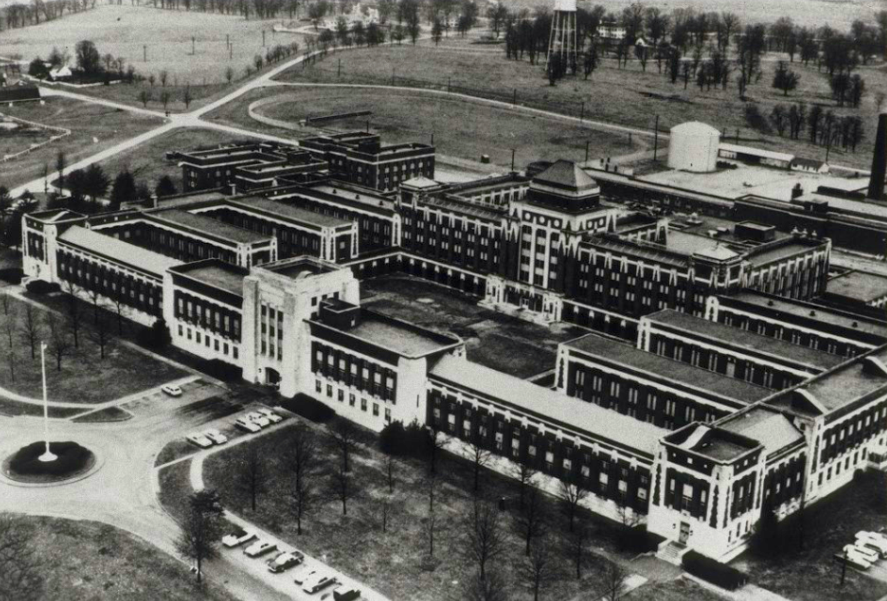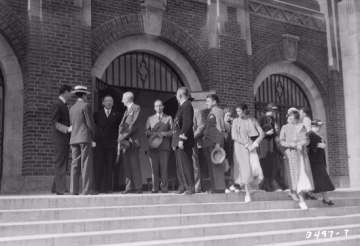
History
On March 13, 1930, the Mellon Committee, consisting of United States Secretary of the Treasury (Mellon), Secretary of War and the Attorney General, announced that Lexington, Kentucky would soon be home to the United States Public Health Service Hospital, commonly referred to as the U.S. Narcotic Farm. As a multi-million dollar project by the federal government, the U.S. Narcotic Farm was one of the first hospitals of its kind in the world (Landau, 1935) established exclusively for treating and curing drug addiction. The other United States Public Health Service Hospital was located in Fort Worth, Texas.

United States Surgeon General Hugh S. Cumming dedicated the sprawling Narcotic Farm situated on over 1,200 acres, on May 25, 1935. During the first year, headed by Dr. Lawrence Kolb, approximately one thousand addicts and violators of U.S. narcotic laws got the opportunity to treat their addiction in a state-of-the-art facility. Previously, drug addiction was treated in terms of criminality rather than “a symptom of an emotional disorder” (Landau, 1935). A separate, 175-bed unit for women was also on the campus of the Narcotic, the only facility that treated women with drug addiction.
Once patients arrived to the Narcotic Farm, treatment would begin immediately. A medical assessment would be completed by a physical along with a psychiatric assessment by a psychiatrist. Once the patient was deemed eligible for admission, physicians would begin withdrawal treatment where titration of the abused drug would be instituted over a period of time, generally two weeks. Once withdrawal treatment was completed, patients would be transferred to the infirmary for physical disorders. The rest of the stay involved a rehabilitation phase to address physical and emotional issues. The average period of treatment ranged from four to six months.
Patients were categorized as being sent from federal prisons, those convicted on charges on violation of narcotic laws and those who voluntarily asked for treatment. Voluntary patients were charged a rate of approximately $5 per day however; the Narcotic Farm would not refuse any patient, voluntary or otherwise, due to a lack of ability to pay (Griffin, 1935).

It’s important to note that the Narcotic Farm had a dual purpose; in treating drug addiction but also as a center for research. Research would play a vital role at the Narcotic Farm until its closure in the late 20th century. The Narcotic Farm also operated three businesses; one built furniture, which was provided to U.S. federal offices, clothing and a farm. According to cost accounting in 1935, all three operations earned profits nearly every year.
In the first decade of operations, the Narcotic Farm had a success rate of 22 percent of men and 30 percent of women. 35 percent of men and 37 percent of women were using narcotics again after their treatment.
As years progressed, the Narcotic Farm did as well. Being one of the only facilities for treating drug addiction also encouraged musical and literary figures to seek treatment. William S. Burroughs, along with his son who carried the same name, received treatment at the Narcotic Farm and wrote about their experiences. Jazz giants Elvin Jones and Chet Baker also received treatment. Though the countryside in Lexington was somewhat isolating, it was proving to be an excellent location for recovering from drug addiction.
By the 1970s, things began dwindling for the Narcotic Farm. Allegations of abuse became widespread and concerns that the Narcotic Farm wasn’t progressing as it had in 1935 would eventually lead to the suspension of therapeutic services. Research continued, however, until the mid-1980s where those operations were transferred to Baltimore, Maryland. The property remained in control of the federal government and in the early 1990s, the property became the United States Federal Medical Center as part of the federal Bureau of Prisons to treat prisoners with medical needs. The Federal Medical Center still exists and operates today in the same, original location.
Contributed by Phil Tkacz & Shawn Logan | contact@kyhi.org
⁘ Works Cited ⁘
- Griffin, Gerald. “Narcotic Farm is dedicated.” The Courier-Journal, 26 May 1935, p. .
- Landau, Joseph. “U.S. Narcotic Farm led the whole world in treating addicts.” The Courier-Journal, 23 September 1951, pp. 1-2.
- Lafayette Studios. Lafayette Studios Photographs: 1930s Decade. University of Kentucky, 17 June 2017, source.
- The Courier-Journal (Louisville, Kentucky) 14 August 1938, pp. 53-54.
Important note:
If you would like to use any information on this website (including text, bios, photos and any other information) we encourage you to contact us. We do not own all of the materials on this website/blog. Many of these materials are courtesy of other sources and the original copyright holders retain all applicable rights under the law. Please remember that information contained on this site, authored/owned by KHI, is provided under a Creative Commons Attribution-NonCommercial-NoDerivatives 4.0 International License.
Photographs, text, illustrations and all other media not authored by KHI belong to their respective authors/owners/copyright holders and are used here for educational purposes only under Title 17 U.S. Code § 107.

